How farmers used California's floods to revive underground aquifers
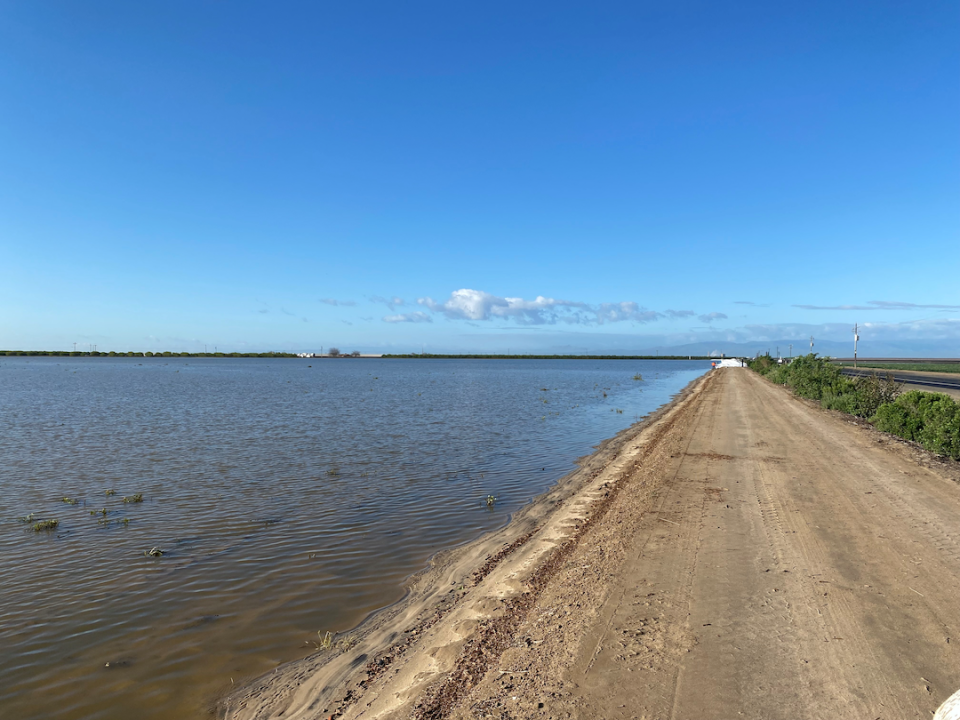
Don Cameron
How farmers used California’s floods to revive underground aquifers
A flooded farm with a dirt road running alongside it
As an onslaught of storms soaked California with record-breaking rain during the winter of 2022-2023, Christine Gemperle found herself crisscrossing her almond orchards in knee-high muck boots and a slicker. She was out in the driving rain doing exactly what many farmers were trying to prevent: opening her irrigation gates and letting the flood rush into her orchards.
She left the gates open until the stormwater pooled three or four inches deep in ditches between her rows of almond trees. A few days later, the water had vanished, having seeped into the sandy soil, at which point Gemperle would open the gates again, repeating the process.
Each time she did so, the vital aquifer deep below her farmland filled up more and more.
“I was just able to put [the water] on [the field] and it went down, put it on again and it went down,” she says.
For generations, during dry periods, California farmers have pumped water from deep underground to keep their crops hydrated when surface water supplies are scarce. Gemperle is no exception.
Reasons to Be Cheerful dives into how flooding in California was turned into an opportunity to revive some of the state’s underground aquifers
![]()
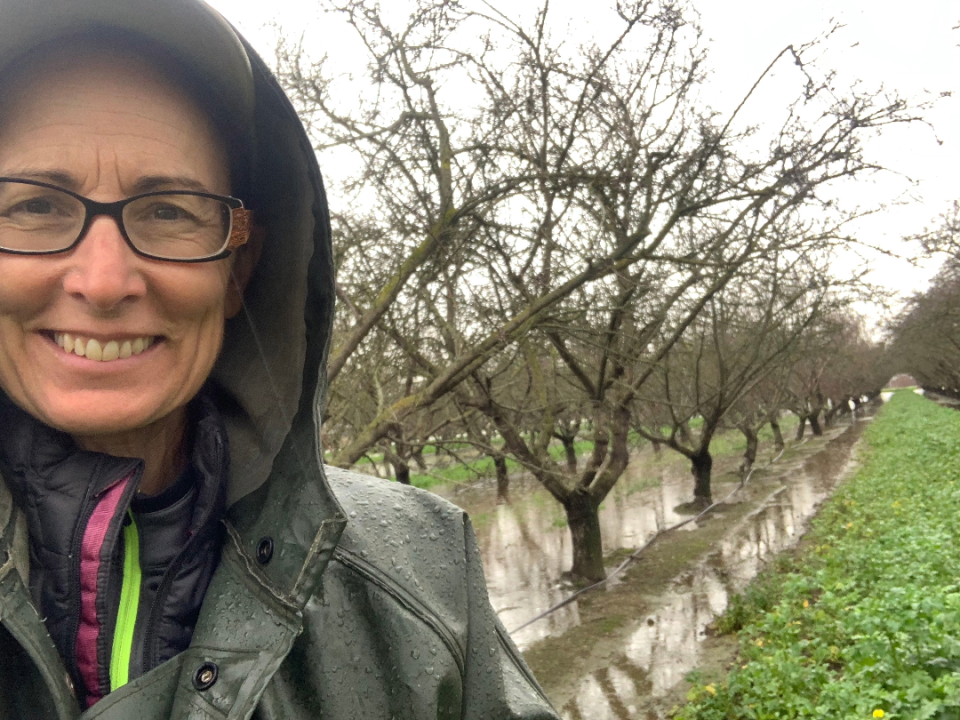
Christine Gemperle
‘We’re going to treat this aquifer like a bank’
Christine Gemperle with her flooded almond farm during the rains of 2023
Photo: Christine Gemperle with her flooded almond farm during the rains of 2023.
Like many of her fellow farmers in California’s agricultural Central Valley, in dry years Gemperle turns to underground aquifers to irrigate the 135-acre almond farm she runs with her brother in Turlock.
These dry years are becoming more frequent –– the megadrought in the American West has made the past 22 years that region’s driest in at least 12 centuries. With less rain, farmers increasingly lean on the state’s aquifers to make up the difference. As a result, between 2003 and 2021, the Central Valley’s supply of groundwater diminished by the equivalent of 1.4 times the capacity of the country’s largest reservoir, Lake Mead.
But if farmers are the biggest takers of California’s dwindling groundwater supply, they are also becoming critical players in filling those aquifers back up. This year, Gemperle Orchards joined a growing number of farms helping to replenish overdrawn aquifers by flooding their orchards and fields with excess stormwater during wet seasons and letting it soak into the ground.
“We’re going to treat this [aquifer] like a bank,” says Gemperle, who’d seen research about the on-farm groundwater recharge method through her role as a member of the Almond Board of California. “Every year that I can put [water] in, I’m going to put in. And then every year that I need, as emergency backup, to take out, I’m going to take out. But I’m going to … watch what I take out to make sure it balances about what I can put in during the wet years.”
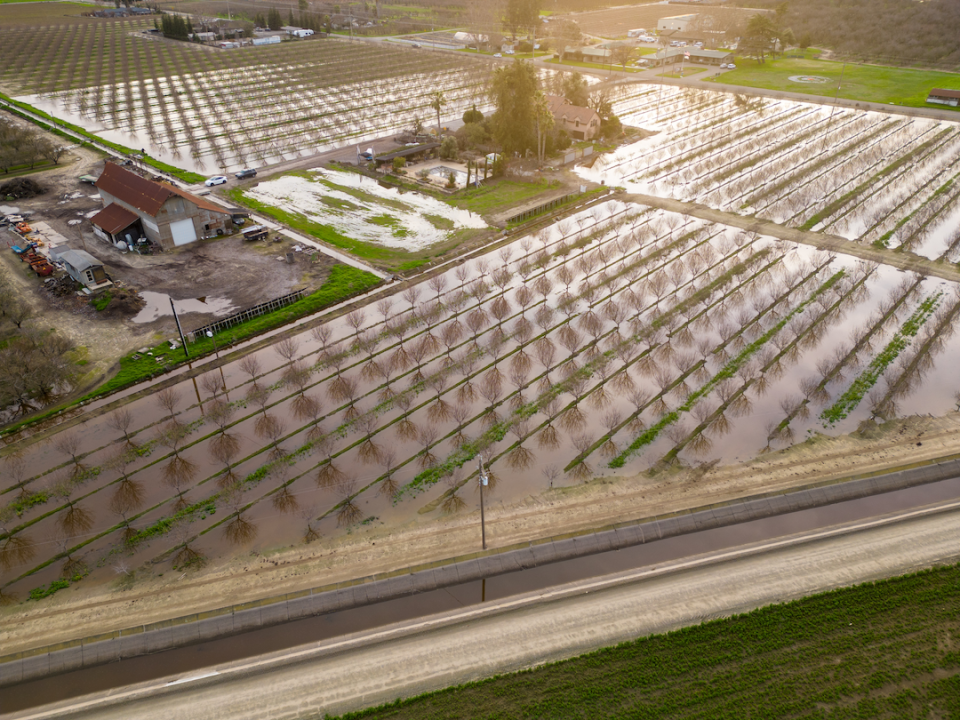
Christine Gemperle
As groundwater becomes more scarce, communities face ongoing struggles
Christine Gemperle’s almond farm recharging an underground aquifer
Photo: Christine Gemperle’s almond farm recharging an underground aquifer
Protecting the Central Valley’s water supply is a matter of national concern. The 400-mile-long region, framed by rugged coastal mountains to the west and the snow-capped Sierra Nevada range to the east, produces about a quarter of all the food consumed in the US. But weather trends have made water access unpredictable. Periods of intense precipitation and flooding punctuate long droughts. Between 2019 and 2021 the region’s groundwater stores declined sharply, at a rate 31 percent faster than in previous droughts.
“We’ve been pumping water out of the ground as if it was an infinite resource and using it during dry periods to substitute for surface water,” says Daniel Mountjoy of Sustainable Conservation. “What that’s doing is putting more and more pressure on groundwater pumping, to the point that groundwater is now becoming a scarce resource as well.”
That scarcity affects people across the state. Along with the agricultural industry, about 85 percent of Californians rely at least in part on groundwater. Now, entire towns are running out of drinking water, particularly rural Latino communities. In 2022, 1,489 wells were reported as dry in California, a more than 40 percent increase over the previous year.
As aquifers dry up, the ground is literally falling beneath Californians’ feet. In parts of the Central Valley, the land subsides at an astonishing rate of about one foot per year, damaging infrastructure like bridges and rupturing canals that bring surface water to communities and farms.
Faced with this looming groundwater crisis, in 2014 California took action by passing the Sustainable Groundwater Management Act, which establishes local water authorities to manage groundwater usage. The landmark legislation laid the groundwork for stabilizing aquifers by empowering the local authorities not only to regulate how much groundwater is extracted, but also to look for opportunities to replenish aquifers in years with lots of precipitation –– years exactly like 2023
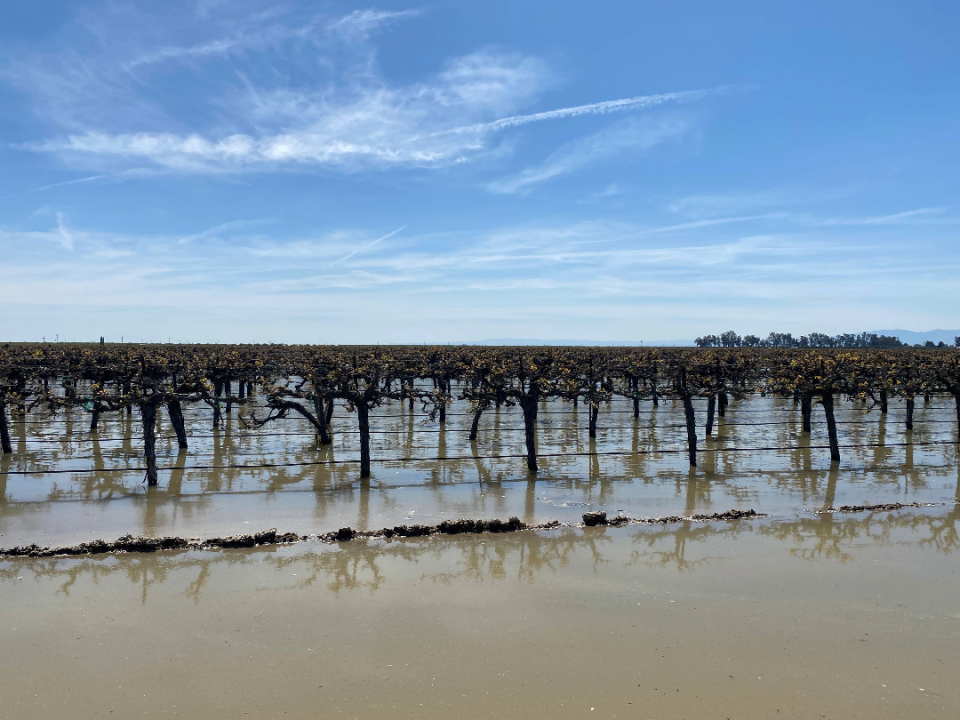
Don Cameron
A risky move in 2011 has pointed the way toward sustainability; farmers and groundwater agencies are taking heed
A flooded vineyard at Terranova Ranch
Photo: A flooded vineyard at Terranova Ranch.
The role of farms in recharging aquifers during particularly wet years began with a bold experiment set in motion by one Central Valley farmer a decade ago.
Don Cameron noticed that the groundwater levels on Terranova Ranch, where he is vice president and general manager, in Helm, California, were dropping by a foot or more each year. So, during the wet winter of 2011, when the wine grape vines were dormant and the region’s rivers were running high, Cameron inundated the vineyard. “Our neighbors thought we were pretty crazy to do that,” he says. “They thought we were going to kill [our crops].”
But Cameron was confident the vines could handle it — he’d seen grapes survive in high waters before. Sure enough, the vines were unharmed. And that summer, his groundwater levels were higher.
He’s repeated the process in every rainy year since, including this one. Since March, Terranova has been flooding vineyards, pistachio orchards, and 350 acres of additional farmland with stormwater. The water got up to three and a half feet deep, which killed about 50 pistachio trees. But by the end of June, the farm had absorbed enough water to cover 15,000 acres a foot deep (a measurement called acre feet), and groundwater levels were rising. “I’m optimistic that we’ll see a rise as we move into the later summer and fall,” the veteran farmer told Reasons to Be Cheerful in July as he prepared for a stretch of scorching 110-degree days.
At his farm, pictured above, Cameron has since invested in infrastructure to channel water to farmland in wet years, with the help of multiple grants, and spoken about his experiences widely. While some farmers were hesitant at first, he’s seen attitudes change.
“I tell people that if they don’t do this, they’re going to be out of luck,” he says. “If they don’t capture this water, long-term they’re not going to be sustainable.”
Even before the Sustainable Groundwater Management Act was passed, many districts in California already had aquifer recharge basins, like ponds dedicated to letting water soak into the ground. But using farmland allows water to sink in across a much broader land area. While the idea gained steam, some irrigation districts jumped in to set up systems to engage local farms.
Then came the massive precipitation of the winter of 2023.
Over the last decade, Tulare Irrigation District has invited growers to take on water during wet seasons. Initially, many weren’t interested, says district manager Aaron Fukuda. Winter is a rare quieter time for busy farmers, and managing wet fields during those down months means extra work.
This year, though, growers in the region had a new incentive. At the peak of drought in May 2022, concern about groundwater levels led the groundwater sustainability agency that oversees Tulare to set limits on pumping. The system, which includes an online tracking dashboard, also works in the reverse: if farms take on excess water in wet seasons to recharge the aquifer, they earn credit to extract additional water from that aquifer later.
The opportunity to treat the aquifer like a savings account — with not just water deposits, but withdrawals, too — changed everything. The timing couldn’t have been better. Historic rainfall inundated the Central Valley starting in December. When growers were invited in January to start running water through their irrigation systems to their fields, they jumped at the chance, Fukuda says: “The day we opened up the phone line we had 80 orders before lunch.”
Over the next several months, farms in the Tulare Irrigation District let water trickle through drip irrigation systems, pool in the trenches of furrowed fields, or flood the land around their trees.
From January through June, the district diverted a total of 256,000 acre feet from swollen waterways, filling up recharge basins and distributing some to farms. About 105,000 acre feet passed through gates that release water onto farmers’ land, some for irrigation needs and some for recharge.
The efforts are paying off. In some wells, water levels are measuring 15 to 20 feet higher than before this wet season. Fukuda believes that by pairing wet-year recharge with management of pumping, the district can minimize the need to leave farmland fallow.
California state officials preliminarily estimate a total of at least 3.8 million acre feet have been recharged across the state this year, including both on-farm and other efforts, though more data will be confirmed next year.
Amid this winter’s deluge, Sustainable Conservation — which has been supporting on-farm recharge — heard from many other districts interested in implementing the approach in their areas.
“This has really been the catalytic year,” Mountjoy says.
In addition to helping to stabilize groundwater stores, the practice promises to help mitigate subsidence, according to Mountjoy. Though aquifer recharge won’t raise ground that has already sunk, he says, it may be able to stop it from sinking further. It can also help with flood mitigation, diverting some high waters away from rivers and reducing the impact of inundation on communities downstream.
The method essentially leverages farmland to address an existential problem in California: When you receive too much water, how do you not only manage the flooding, but also store that water for future years when you don’t get enough?
“You need recharge basins and on-farm recharge to capture the big gulps in years like this,” Mountjoy says.
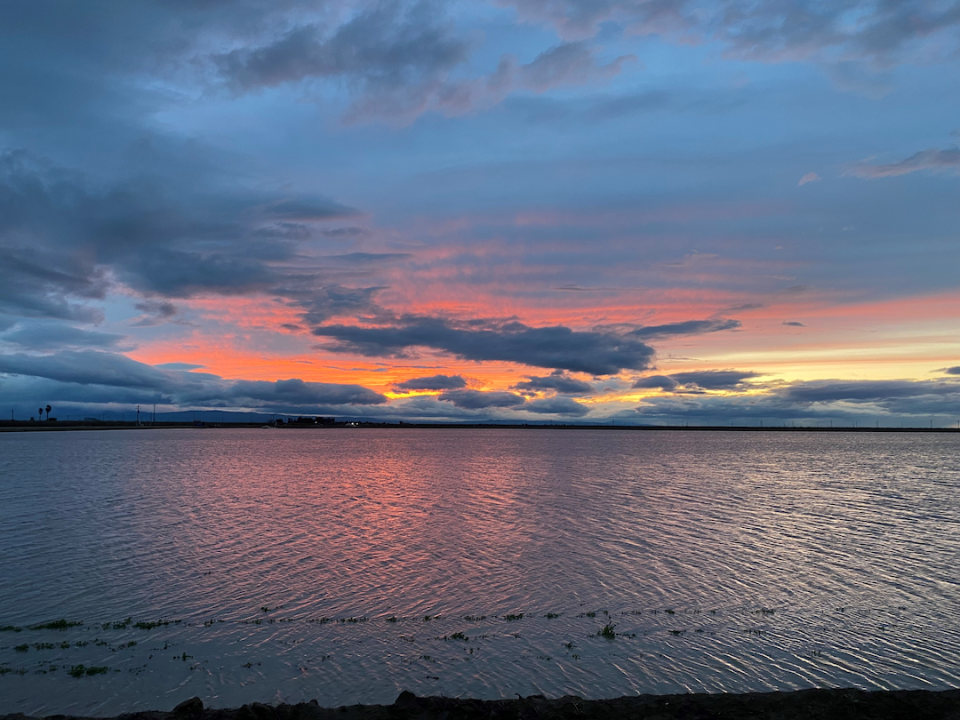
Don Cameron
Aquifer recharge and water use must be closely managed to maintain a healthy water supply
A flooded farm
While on-farm aquifer recharge is gaining popularity, on its own the practice will not be enough to completely address the region’s groundwater overdraft. Researchers estimate that up to 25 percent of the San Joaquin Valley’s groundwater depletion can be addressed by returning water to the ground.
Recharging aquifers and then continuing to use water at the same rate is “a risky bet,” notes Hannah Waterhouse of the University of California at Santa Cruz, a soil biochemist who has studied on-farm recharge.
“There needs to be decreases in pumping,” Waterhouse says. “That has to be a part of the story.”
Using farmland to replenish aquifers also raises questions about implications for groundwater quality, according to Waterhouse. As water trickles down into the aquifer, it carries with it nitrate from excess fertilizer, a contaminant linked to negative health consequences. Putting large amounts of water on fields could potentially flush older built-up nitrate into the groundwater supply.
But Waterhouse says research models have found that, if fertilizer use is reduced, adding water to the depleted aquifers could improve groundwater quality by diluting the nitrates already in there. This could help restore drinking water to communities where wells have run dry.
Meanwhile, after irrigating 40 acres of almond orchards this winter, the groundwater level on Gemperle Orchards rose by about a foot.
Christine Gemperle says that the farm took a total of 44 acre feet in stormwater –– nearly double the 26 acre feet of well water that the farm used during the drought in 2022.
The trees don’t seem to have been harmed by the process, Gemperle says, and the young ones have put on about four feet of growth. Water was restored to her neighbor’s well, too, which ran dry last year.
Gemperle budgets groundwater carefully, and plans water use to try to keep it healthy. Recharging the aquifer helps the small family farm prepare for uncertain weather ahead.
“It’s nice to have that backup,” Gemperle says. “With climate change, in order to be resilient, we have to be super flexible.”
This story was produced by Reasons to Be Cheerful and reviewed and distributed by Stacker Media.